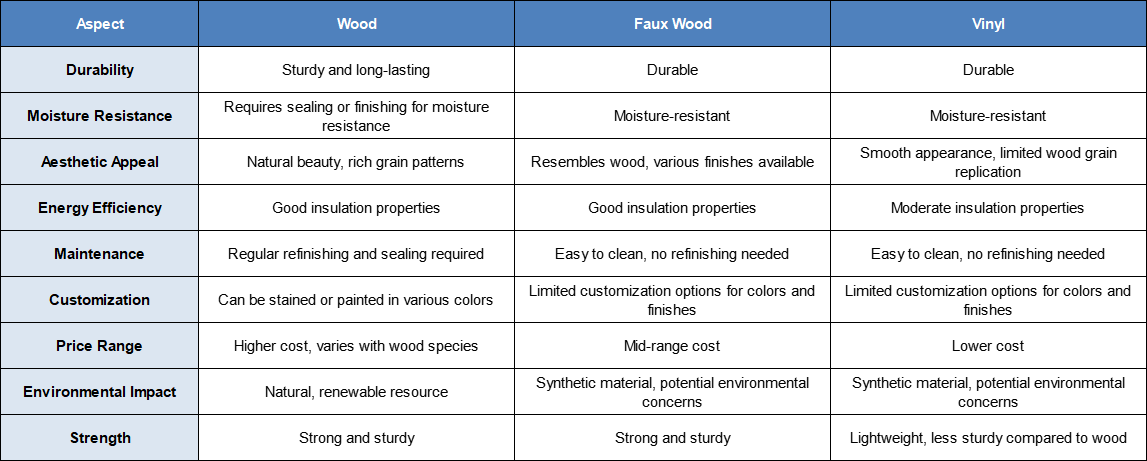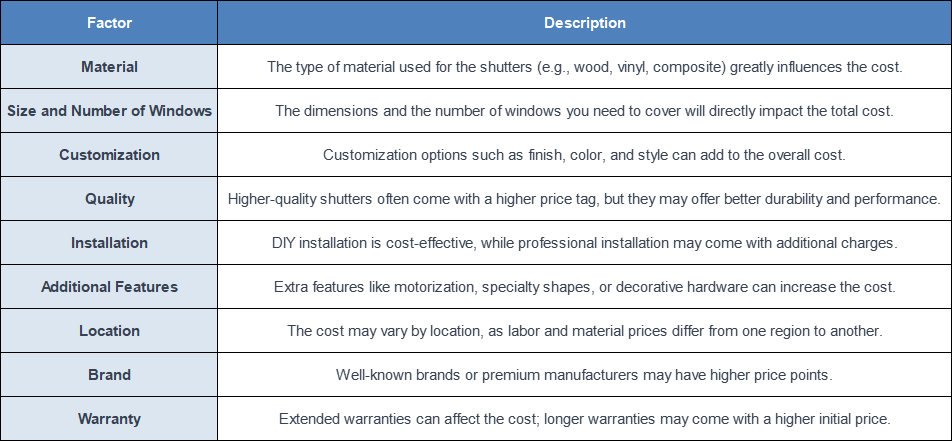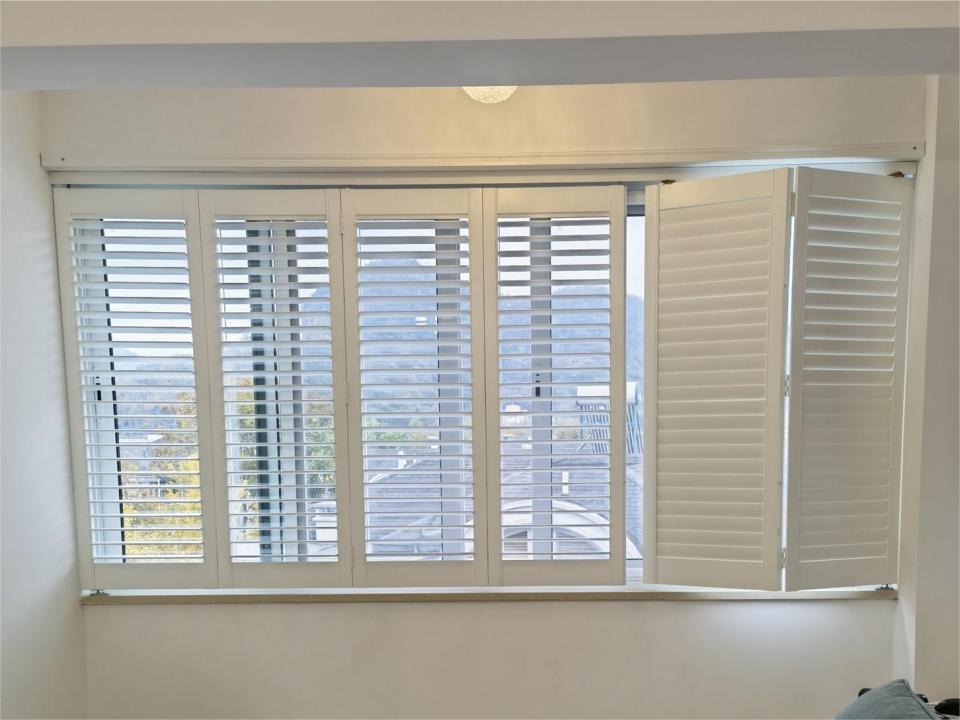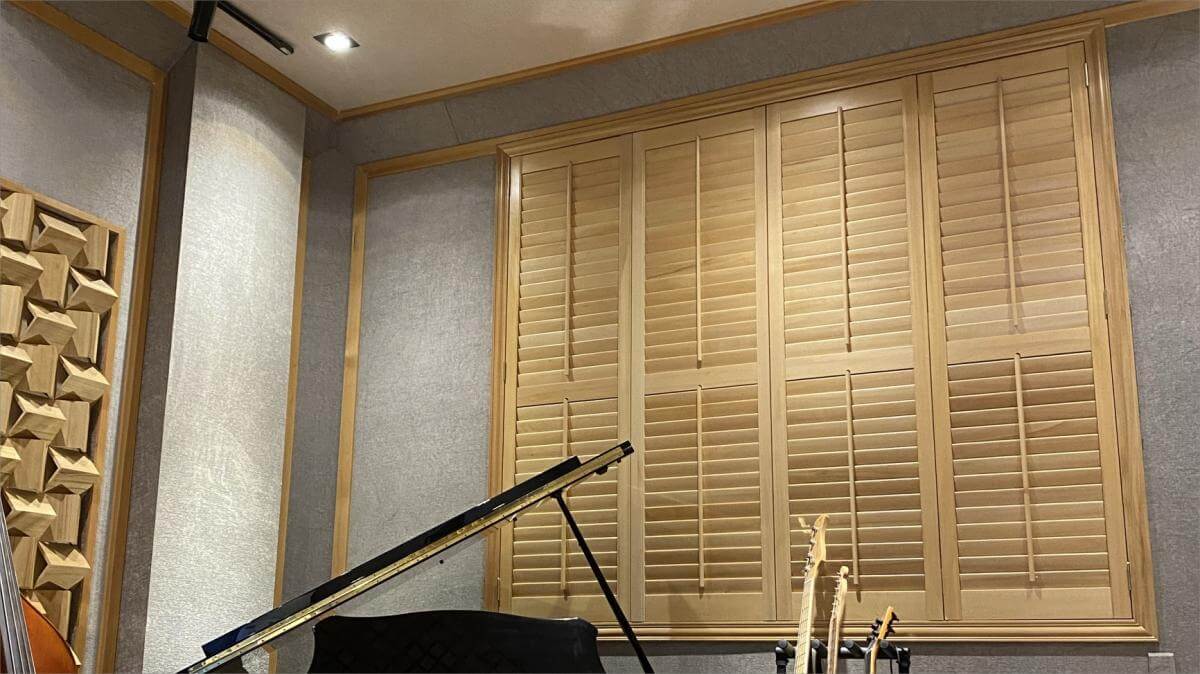Interior window shutters have become a popular choice for homeowners seeking a harmonious blend of practicality and aesthetics. If you’re considering adding these versatile window treatments to your home, there are several key factors to consider before making your purchase. In this guide, we’ll walk you through the essential aspects of interior window shutters, helping you make an informed decision that suits your needs and preferences.
Benefits of Interior Window Shutters
Interior window shutters are a great option for homeowners who want to enjoy various benefits. These benefits are important to know before you decide to install them in your home:
- Classic Style: Interior window shutters have a classic style that enhances any room. They can complement both traditional and modern interior designs with their elegance and charm.
- Light Control: One of the main benefits of interior shutters is their amazing light control. You can adjust the slats to control the amount of natural light that enters the room, creating the mood you want.
- Privacy: Shutters are a perfect solution for privacy. You can change the slats to block the view from the outside while still letting air and light in your space.
- Energy Efficiency: Interior shutters are great insulators. When closed, they form a barrier that helps keep the temperature inside your home stable. This can save energy by lowering the need for heating and cooling.
- Low Maintenance: Shutters are easy to maintain. A simple dusting or wiping with a damp cloth is usually enough to keep them clean and fresh.
- Customization: They are very customizable, allowing you to pick the color, style, and size that matches your home’s decor.

Considering these benefits in your decision-making process can help you see why interior window shutters are a wonderful choice for your home. Their benefits go beyond aesthetics, making them a useful investment in comfort and energy efficiency.
Types of Interior Window Shutters
Interior window shutters come in a variety of design styles, each with its unique features and applications. Choosing the right type depends on your aesthetic preferences, the level of light and privacy control you desire, and the architecture of your space. Let’s explore some of the most popular design styles:
Full-Height Shutters:
- Unique Features: Full-height shutters cover the entire window from top to bottom. They offer a clean and classic look.
- Use Cases: Ideal for tall windows or rooms where maximum privacy and light control are required. They work well in both traditional and contemporary settings.
Café-Style Shutters:
- Unique Features: Café-style shutters cover only the lower portion of the window, leaving the top exposed. They offer a chic and open feel.
- Use Cases: Perfect for areas where privacy is needed at the lower half of the window while maintaining an open view at the top. They are commonly used in kitchens and dining rooms.
Tier-on-Tier Shutters:
- Unique Features: Tier-on-tier shutters consist of two panels, one on top of the other, which can be operated independently. They provide versatile light and privacy control.
- Use Cases: Suited for rooms where you want the flexibility to adjust the upper and lower sections independently. Great for bedrooms, living rooms, or street-facing windows.
Bi-Fold Shutters:
- Unique Features: Bi-fold shutters consist of multiple hinged panels that can be folded back, creating a wide opening.
- Use Cases: Ideal for large windows, room dividers, or patio doors. They offer unobstructed views when fully opened and excellent light control when closed.
Bypass Shutters:
- Unique Features: Bypass shutters slide on a track and overlap each other when opened. They save space and provide a modern look.
- Use Cases: Suitable for areas with limited space or sliding glass doors. They allow for easy access to the outdoors and efficient light control.
Solid Panel Shutters:
- Unique Features: Solid panel shutters have no louvers and consist of a single, solid piece. They offer maximum privacy and light blockage.
- Use Cases: Ideal for bedrooms, nurseries, or rooms where complete darkness and privacy are essential, such as media rooms.
Shutter Blinds:
- Unique Features: Shutter blinds combine the look of shutters with the functionality of blinds, featuring adjustable horizontal slats.
- Use Cases: They are versatile and work well in various settings, providing style and practical light control.
Selecting the right interior window shutters depends on your specific needs and the aesthetic you want to achieve. Each style offers a unique blend of form and function, allowing you to personalize your space while enjoying the benefits of shutters.
Materials of Interior Window Shutters
When it comes to choosing the material for your interior window shutters, you’ll find several options, each with its own set of advantages and disadvantages. Understanding these materials is essential to make an informed decision:
Wood: Wood shutters are typically made from natural wood, such as basswood, poplar, or cedar, known for their natural beauty and strength.
Pros:
- Classic and elegant appearance.
- Excellent insulating properties.
- Customizable with various finishes and stains.
Cons:
- More expensive than some alternatives.
- They may require more maintenance, including occasional refinishing.
Choosing Wood Shutters: Opt for wood if you value traditional aesthetics and are willing to invest in a premium material.
Vinyl: Vinyl shutters are made of a durable, moisture-resistant PVC material.
Pros:
- Highly durable and resistant to moisture.
- Low maintenance, as they don’t require staining or painting.
- Budget-friendly option.
Cons:
- Limited color and finish options compared to wood.
- It may not provide the same warmth as natural wood.
Choosing Vinyl Shutters: Vinyl is a practical choice for areas with high humidity and those on a budget.
Composite (Faux Wood): Composite shutters are made of engineered wood products, such as MDF (Medium-Density Fiberboard), with a polyvinyl or PVC coating.
Pros:
- It mimics the look of real wood.
- Resistant to moisture, warping, and cracking.
- They are easy to maintain and don’t require refinishing.
Cons:
- It may be more expensive than basic vinyl.
- Composite shutters can be heavier than other materials.
Choosing Composite Shutters: Consider composite shutters for a balance between the look of wood and the durability of vinyl.

When selecting the right material for your interior window shutters, consider your location, the specific room, your budget, and your aesthetic preferences. Choosing the best material will ensure that your shutters not only look beautiful but also perform well over time in your unique home environment.
Cost of Interior Window Shutters
The cost of interior window shutters depends on several factors, such as the material, the size and shape of the windows and doors, the color and style of the shutters, the installation process, and the location and availability of the supplier. According to some sources, the average cost of interior window shutters ranges from $70 to $350 per window, depending on the type and quality of the shutters.
The material of the shutters.
Interior window shutters can be made of real wood, vinyl, or composite materials. Real wood shutters are usually the most expensive, but they also offer the most natural and elegant look. Vinyl shutters are the cheapest and easiest to clean, but they may fade or crack over time. Composite shutters are made of a mixture of wood and synthetic materials, and they offer a balance between quality and cost.
The size of the windows.
Larger or irregularly shaped windows may require more material and labor to fit the shutters. For example, bay windows, arched windows, or French doors may need custom-made shutters that accommodate their curves and angles. Additionally, some windows may have special features that require extra hardware or accessories for the shutters, such as tilt-in windows or casement windows.
The customization of the shutters.
Interior window shutters can be customized to fit any shape, size, or style of window. You can choose from different colors, finishes, frames, hinges, tilt rods, louvers, dividers, and hardware to match your personal preference and home decor. However, customization usually comes at a higher price than standard options.
The installation of the shutters.
Professional installation is a key component of the cost. Installation fees can vary depending on your location, the complexity of the job, and the number of windows and doors you’re outfitting. Typically, installation costs can add $200 to $600 per window.
The location of your shutter supplier.
The supplier’s location determines the cost of shipping and delivery. Depending on your location, this could add extra expenses to your budget. Moreover, different regions have varying tax rates and additional fees. These factors will affect the final price.

Tips on Saving Money on Interior Window Shutters
Interior window shutters offer a range of benefits, including heat and light control, enhanced privacy, and an aesthetic upgrade for your home. However, there are several effective ways to save money on these versatile window coverings.
Choose a durable and low-maintenance material.
Opt for materials that can withstand time and minimize the need for costly repairs or replacements. For instance, composite shutters are more resistant to wear and tear than traditional wood shutters. Vinyl shutters are not only durable but also easy to clean, reducing maintenance costs.
Choose a neutral color for your shutters.
Select a neutral color that seamlessly complements any decor, eliminating the need to pay extra for custom colors. White shutters are often a cost-effective choice, as they are both common and versatile. To introduce color or contrast to your windows, consider using curtains or drapes to achieve a fresh look without altering the shutters.
Choose a simple style of shutter design.
Choose a straightforward shutter style that can accommodate various window shapes and sizes. Avoid extra expenses associated with custom shapes or intricate features. Traditional shutters, with their narrower louvers, are more budget-friendly and can fit most windows. If you desire greater control over light and airflow, adjustable louvers or tilt rods can provide flexibility without compromising style.
Compare different suppliers and installers.
For example, some suppliers may offer free shipping or delivery if one orders a certain amount of shutters, or some installers may offer a discount if one installs multiple windows or rooms simultaneously. However, one should also check the quality and reputation of the supplier or installer before making a deal, as some may offer low prices but poor service or products.
Install the shutters during off-seasons or low-demand periods.
When there may be less competition or more availability, for example, some suppliers or installers may lower their prices during winter or summer when there is less demand for interior window shutters, or they may have more stock or inventory of certain types or colors of shutters they want to clear out. However, one should also consider the weather and the convenience of installing the shutters during these periods, as some may not be suitable for certain climates or schedules.

Interior Window Shutters vs. Curtains vs. Blinds vs. Shades
When choosing window treatments for your home, you have many options. Each type of window covering has advantages and disadvantages, depending on your needs, preferences, and budget.
Interior Window Shutters
Interior window shutters are solid panels that are attached to the inside of the window frame. They have louvers or slats that can be tilted to adjust the amount of light and air that enters the room. They can also be opened or closed completely for privacy and security.
Advantages:
- They are durable and easy to maintain.
- They are energy-efficient and insulating.
- They are stylish and elegant.
Disadvantages:
- They are expensive and difficult to install.
- They are bulky and heavy.
The average cost of interior window shutters ranges from $70 to $350 per window, depending on the type, size, and quality.
Curtains
Curtains are fabric panels that hang from a rod or rail above the window. They can be drawn open or closed to cover or expose the window. They come in various lengths, widths, colors, patterns, and materials.
Advantages:
- They are versatile and customizable.
- They are soft and cozy.
- They are affordable and easy to install.
Disadvantages:
- They are not very effective at blocking light and heat.
- They are prone to fading, staining, and wrinkling.
The average cost of curtains ranges from $10 to $200 per panel, depending on the size, material, and quality of the curtains.
Blinds
Blinds are window coverings that consist of horizontal or vertical slats that can be raised or lowered by a cord or wand. The slats can also be tilted to adjust the amount of light and air that enters the room. Blinds can be wood, faux wood, vinyl, aluminum, bamboo, or fabric.
Advantages:
- They are practical and functional.
- They are durable and easy to clean.
- They are economical and modern.
Disadvantages:
- They are not very insulating or soundproofing.
- They are not very decorative or cozy.
The average cost of blinds ranges from $20 to $200 per window, depending on the type, size, and quality of the blinds.
Shades
Shades are window coverings that consist of a single piece of fabric or material that can be rolled or folded up or down by a cord or spring. Shades can be made of various materials, such as cotton, linen, silk, bamboo, paper, or vinyl.
Advantages:
- They are elegant and cozy.
- They are insulating and soundproofing.
- They are customizable and creative.
Disadvantages:
- They are not very effective at light control.
- They are prone to sagging, tearing, and fading.
The average cost of shades ranges from $30 to $300 per window, depending on the type, size, and quality of the shades.

In conclusion, interior window shutters are versatile and elegant for enhancing your living space. With their practical benefits and aesthetic appeal, they can transform the atmosphere in your home. By understanding the considerations outlined in this guide, you can make an informed decision that suits your lifestyle and preferences. So, explore your options, seek professional advice if needed, and take your time to find the perfect interior window shutters to elevate your home’s style and functionality.

